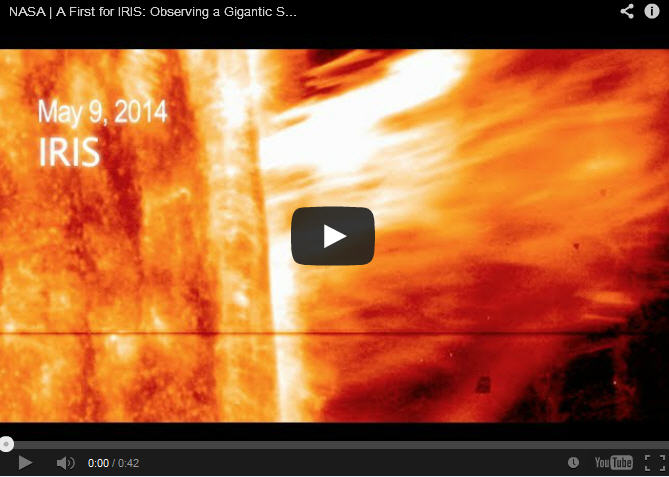A First for NASA's IRIS: Observing a Gigantic Eruption of Solar Material

A coronal mass ejection burst off the side of the sun on May 9, 2014. The giant sheet of solar material erupting was the first CME seen by NASA's Interface Region Imaging Spectrograph, or IRIS. The field of view seen here is about five Earths wide and about seven-and-a-half Earths tall. Image Credit: NASA/LMSAL/IRIS/SDO/Goddard
This was the first CME observed by the Interface Region Imaging Spectrograph, or IRIS, which launched in June 2013 to peer into the lowest levels of the sun's atmosphere with better resolution than ever before. Watch the movie to see how a curtain of solar material erupts outward at speeds of 1.5 million miles per hour.
IRIS must commit to pointing at certain areas of the sun at least a day in advance, so catching a CME in the act involves some educated guesses and a little bit of luck.
“We focus in on active regions to try to see a flare or a CME,” said Bart De Pontieu, the IRIS science lead at Lockheed Martin Solar & Astrophysics Laboratory in Palo Alto, California. “And then we wait and hope that we'll catch something. This is the first clear CME for IRIS so the team is very excited.”
The IRIS imagery focuses in on material of 30,000 kelvins at the base, or foot points, of the CME. The line moving across the middle of the movie is the entrance slit for IRIS's spectrograph, an instrument that can split light into its many wavelengths – a technique that ultimately allows scientists to measure temperature, velocity and density of the solar material behind the slit.
The field of view for this imagery is about five Earths wide and about seven-and-a-half Earths tall.
Lockheed Martin Solar & Astrophysics Laboratory designed the IRIS Observatory and manages the mission. NASA's Ames Research Center in Moffett Field, California, provides mission operations and ground data systems. NASA's Goddard Space Flight Center in Greenbelt, Maryland, manages the Explorers Program for NASA's Science Mission Directorate in Washington, D.C.
Karen C. Fox
NASA's Goddard Space Flight Center, Greenbelt, Maryland
Media Contact
All latest news from the category: Physics and Astronomy
This area deals with the fundamental laws and building blocks of nature and how they interact, the properties and the behavior of matter, and research into space and time and their structures.
innovations-report provides in-depth reports and articles on subjects such as astrophysics, laser technologies, nuclear, quantum, particle and solid-state physics, nanotechnologies, planetary research and findings (Mars, Venus) and developments related to the Hubble Telescope.
Newest articles

A universal framework for spatial biology
SpatialData is a freely accessible tool to unify and integrate data from different omics technologies accounting for spatial information, which can provide holistic insights into health and disease. Biological processes…

How complex biological processes arise
A $20 million grant from the U.S. National Science Foundation (NSF) will support the establishment and operation of the National Synthesis Center for Emergence in the Molecular and Cellular Sciences (NCEMS) at…

Airborne single-photon lidar system achieves high-resolution 3D imaging
Compact, low-power system opens doors for photon-efficient drone and satellite-based environmental monitoring and mapping. Researchers have developed a compact and lightweight single-photon airborne lidar system that can acquire high-resolution 3D…





















